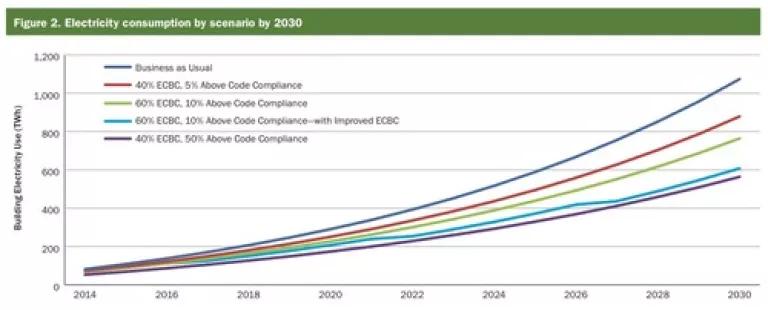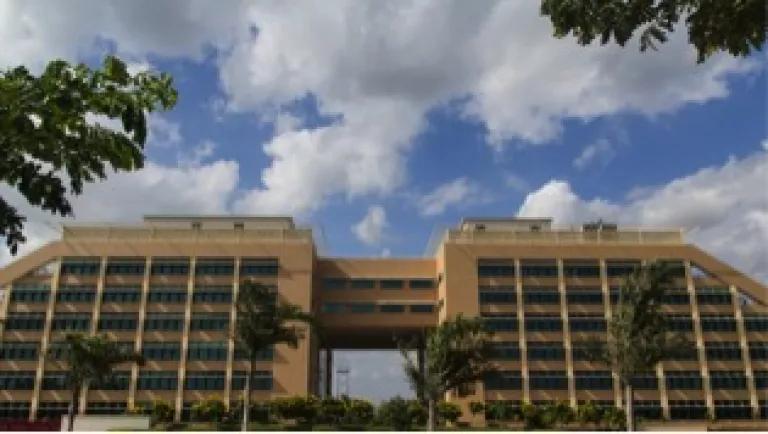
Co-authored by Srinivas Chary Vedala (Dean, Administrative Staff College of India)
As the country celebrated its 65th Republic Day, one Indian state took a huge step towards greater energy independence. This week, Andhra Pradesh (AP) solidified its status as an energy efficiency leader, adopting a comprehensive and innovative adaptation of the Energy Conservation Building Code (ECBC) for commercial and high-rise residential buildings. As India’s fourth largest state and home to the booming city of Hyderabad, AP’s adoption of the code will generate enormous energy savings and sets a leading example for other states.
In fact, according to a new analysis in the issue brief, Building Efficient Citie
s: Strengthening the Indian Real Estate Market Through Codes and Incentives by NRDC and the Administrative Staff College of India (ASCI), and supported in part by Shakti Sustainable Energy Foundation, minimal code compliance by commercial buildings in Andhra Pradesh (40% complying with the ECBC, 5% exceeding the code) translates into 86 terawatt hours of cumulative energy saved by 2030, enough to power as many as 8.9 million Indian households per year over the next 17 years based on the current level of annual energy consumption.
Even more impressive, if states across India adopted the Energy Conservation Building Code and developers participated in strong programs for rating commercial buildings, an estimated 3,453 TWh of cumulative electricity could be saved by 2030. This is equivalent to powering 358 million Indian homes annually between 2014 and 2030 based on current annual consumption levels for electrified homes. Additionally, 1,184 million tons of carbon dioxide emissions could be avoided by 2030 – equivalent to the annual emissions from more than 17 typical coal-fired power plants over that same time period.

Figure 2 from our Building Efficient Cities issue brief demonstrating the tremendous energy savings possible if the ECBC and ratings programs flourish across India.
Savings like that are no small feat when buildings account for nearly a third of India’s total electricity consumption, according to the Bureau of Energy Efficiency (BEE). Structures compliant with the ECBC are generally expected to use 40% to 60% less energy compared to conventional buildings. As Dr. A.P.J. Abdul Kalam, former President of India, recently said, “building energy efficiency is perhaps the most economically feasible and convenient way to generate energy.” This widely untapped energy resource is key to meeting the rising demand for energy as construction increases across the country, locking in energy and cost savings for the life of each energy efficient building constructed.
This tailored version of the ECBC is unique in three key ways:
- Expert-developed code with extensive stakeholder consultation: The state of Andhra Pradesh collaborated with real estate developers including the Confederation of Real Estate Developers’ Association of India (CREDAI) and the Andhra Pradesh Real Estate Developers’ Association (APREDA) and experts at NRDC, ASCI and the Indian Institutes of Information Technology to develop an innovative approach to compliance. The government-organized steering committee ensured extensive stakeholder consultation and technical expertise throughout the code’s development.
- Phased-in implementation: Andhra Pradesh’s code helps guarantee compliance by providing a phased-in approach to implement the code’s technical and practical aspects. In its initial phase after it becomes effective August 2014, the state will ramp up and build capacity through trainings with the municipal officers who will implement code. Workshops with real estate developers will also be held to build awareness and broader engagement before complete code roll-out. After this phase, the code will be ready for full implementation and compliance will be enforced.
- Flexible compliance framework: AP building code can be complied with in one of two ways, either through a “Prescriptive Method” – which lists requirements for energy efficiency measures – or through a “Whole Building Performance Method” – which entails using design software to optimize building energy performance while minimizing cost. This flexibility encourages developers, architects, and designers to respond to changing technologies and prices over time, easing compliance challenges.

India’s first commercial radiant cooled building, the Infosys Software Development Building, is located in Hyderabad, Andhra Pradesh, India. Credit: Bhaskar Deol.
Looking Back at ECBC’s Progress
In 2013, BEE commissioned the consultant group MITCON to help India achieve its target of 65% ECBC compliance by 2017. Since the code’s creation in 2007, BEE has developed compliance processes and tools, conducted many training programs and “empanelled” (accredited) expert architects and energy service companies (ESCOs). In addition to these early code adoption milestones, enrollment in ratings programs has increased across India. In the past 5 years, 432 buildings have rated and registered under energy efficiency programs so far including the star rating labeling system, GRIHA, and LEED, which is estimated to save a combined 607 MW of electricity.
Looking Ahead to Broader ECBC Implementation
Many other Indian states are currently in the process of adopting the ECBC into state laws. Despite these early ECBC accomplishments, much more remains to be done to achieve the code’s full potential.
NRDC and its partners work to address barriers to energy efficiency at all levels, across government and private sectors. NRDC and ASCI are releasing a report, “Building Efficient Cities” that focuses on moving the majority of India’s development community (the “middle of the market”) toward greater adoption of energy efficiency measures. NRDC and ASCI are also writing a series of case studies featuring efficient buildings in India such as Godrej Bhavan in Mumbai, making clear the real cost savings presented by energy efficiency. The two organizations are also completing a series of interviews with developers, building engineers, and other building efficiency stakeholders to highlight the industry’s perspective on the ECBC.
With the code operationalized in Andhra Pradesh, India is one state closer to meeting BEE’s targeted annual national savings of 1.7 billion kWh by 2017. As India’s heritage and achievements are celebrated this Republic Day, the country should look ahead toward increasing its energy independence in the future. More states should join AP and lead the way by adopting the ECBC, accelerating energy efficient cities across India and with it, India’s energy future.
Contributions from Sarah Klug, NRDC MAP Fellow, Kristina Johnson, NRDC India Initiative Program Assistant, and Meredith Connolly, NRDC Energy Law & Policy Fellow.
